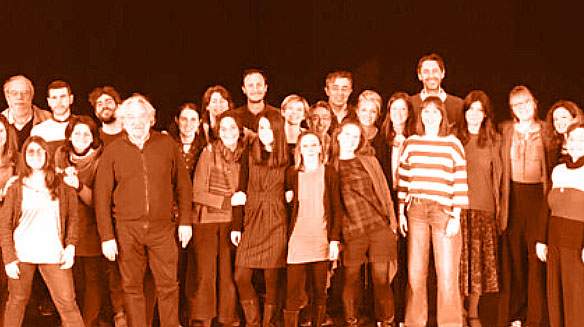Fondazione Fitzcarraldo, the Turin-based cultural research and planning center, raises its voice to support cultural workers, among those most affected by the health emergency due to the spread of the Covid-19 coronavirus pandemic. The first thought is one of gratitude toward them: “the thrill of a live concert, the emotion during a play, the laughter at a good movie, the amazement in front of a work of art, the melancholy at the end of a novel we fell in love with: we have all felt at least one of these sensations, and for this we must be grateful to all those who make them possible: the workers of culture,” the foundation writes in a note. That is why the will is to stand in support of the weakest, self-employed and intermittent, to ask the government for attention to culture workers, especially the “invisibles,” that is, those with special contractual forms that are not, to date, the subject of reconnaissance and specific support interventions that are much needed.
However, the fragmentation of the cultural world, which is largely composed of small and micro enterprises and characterized by precarious contractual forms, constitutes a taxonomy that is difficult to include in the aid and support measures during a crisis, which are nevertheless necessary to safeguard this ecosystem. Law Decree 18/2020 “Cura Italia” of March 17, according to the Fitzcarraldo Foundation, denotes all the difficulty decision makers have in interpreting the multiple needs of the sector, which is why the center felt it was essential to provide a point of view to identify areas of exclusion that might emerge in aid and support measures.
Meanwhile, the foundation points out in its report titled Notes for Defining Interventions to Support the Invisible, that extending the scope of aid to all workers in the sector thus becomes an essential tool for the resilience of the entire production system. The report first identifies areas of intervention:publishing (“where editors, translators,” the text reads, “offer individual work services and where owners of small publishing houses also responsible for a production of high quality appear as administrators under co.co.co without employees”), the live show business (characterized by services of work and artistic workers largely afferent to intermittent contracts, from which not even large institutions, festivals and reviews are exempt), the world of grassroots music (the work of technicians employed in shows and events), the world of associationism (which does not access the minimum requirements to benefit from social shock absorbers, but manages, thanks to a’irrigation of labor and resources drop by drop, to maintain the vitality of urban and rural fabrics allowing the flourishing of events, initiatives, concerts), the professionals who provide services to the world of cultural heritage, museums, libraries, archives, through associations or individual experts engaged in various professional activities (curatorships of exhibitions and museums, organization of exhibitions, tourist guides, etc.). “A large part of the professional world of culture,” reads the Fitzcarraldo Foundation report, “is located within an area of functions outsourced by larger institutions and industries that objectively constitutes an organic and indispensable compartment of the cultural industry and institutions in functional terms, while subjectively it takes on the fragmentary and pulviscular dimension of a multitude of individual professionals outside the main and minimum conditions of protection. Beyond the ethical requirement of protecting the work for all, this very close interdependence between the level of the individual and cultural production at all other organizational and corporate levels is one of the reasons why forms of aid and protection must be extended to all workers in an attempt to contain structural and ”patrimonial“ damage to the entire cultural system.”
The first step, according to the Foundation, is to overcome fragmentation: that is, there is a need for “a quantification of the target audience, which is currently outside the forecasts of intervention and the specific conditions in which the different sectors affected by this condition find themselves, so that the resources provided represent both a contribution to alleviating an acute crisis situation, but also the first step to get out of a fragmentation which proves to be a heavy constraint in the labor market even in non-exceptional conditions,” and again, “a clear definition of those entitled to aid, with their cases and with the identification of specific modes of intervention is also the first step for policyfuture: the economic effort to cope with the crisis will mobilize an exceptional effort that is difficult to replicate in the future,” as well as “a careful use of economic resources to overcome the emergency and aim toward a strategic horizon,” identified as a precondition for optimizing investment in the direction of maximizing public utility over time.
It therefore turns out to be “of crucial importance,” the report concludes, “to precisely perimeter the currently uncovered areas and the conceivable modes of intervention in order to define the amount of resources needed, the methods of access, the eligible cases and the disbursement procedures. Therefore, it is requested to be able to use the elaborations of the databases in the MEF’s availability to analyze at a statistical and aggregate level the data on IRPEF contributions of companies, institutions, associations and enterprises falling within the relevant ATECO codes, using taxonomies suitable for grouping contractual cases into coherent sets. This integration of the database to be considered in conjunction with the sources listed above would make it possible to organize knowledge useful for designing measures that have a capacity to affect conditions that are particularly extensive and simultaneously fragmented, identifying appropriate paths to meet workers in difficulty today.”
 |
| Fitzcarraldo Foundation alongside cultural workers, especially precarious workers: here's how the government should act |
Warning: the translation into English of the original Italian article was created using automatic tools. We undertake to review all articles, but we do not guarantee the total absence of inaccuracies in the translation due to the program. You can find the original by clicking on the ITA button. If you find any mistake,please contact us.